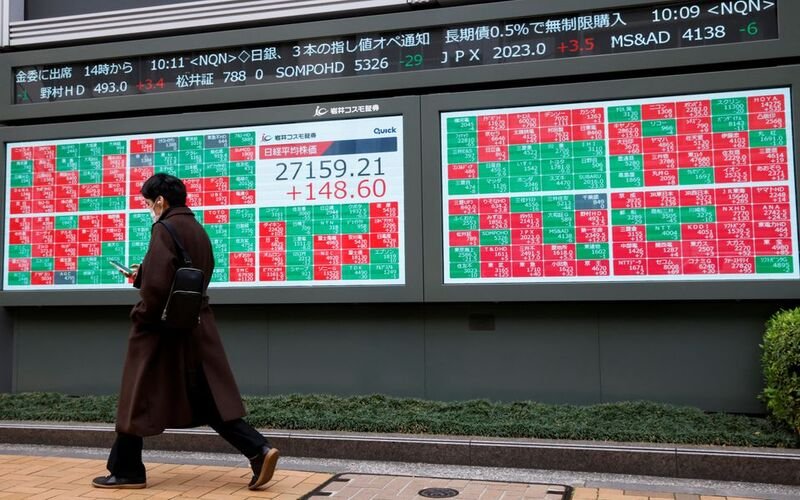Stocks in Asia slump on rate jitters. Stronger-than-expected U.S. consumer pricing data boosted the argument for the Federal Reserve to keep rates higher for longer, which caused Asian equities to fall on Friday and were headed for their largest one-day percentage decrease in a week.
After a three-week high on Thursday, the broadest MSCI index of Asia-Pacific equities outside Japan (.MIAPJ0000PUS) dropped 1.2%. However, it is still expected to post a respectable weekly gain of 1.4%, ending a three-week losing run.
With German DAX futures down 0.14%, FTSE futures down 0.05%, and Eurostoxx 50 futures down 0.19%, the negative mood in Europe was expected to continue. The attention will be on inflation statistics from Sweden, Spain, and France scheduled later today.
A surprising gain in rental prices was included in a rise in U.S. consumer prices for September, and traders now perceive a greater likelihood that the Fed will ultimately deliver another rate hike this year. Compared to the 28% possibility observed before the CPI announcement, futures contracts that settle to the Fed policy rate now represent a 40% probability of a rate rise in December.
According to Ryan Brandham, head of global capital markets for Validus Risk Management in North America, the statistics underscore the difficulties the Fed will encounter in reducing inflation to its 2% objective.
Separate statistics also revealed that during the week ending September 30, the number of Americans getting benefits following a first week of aid—a proxy for hiring—rose 30,000 to a still-low 1.702 million.
“The labour market softening is key to the Fed achieving its goal of returning inflation to target, and the hawks calling for at least another hike will be supported based on these numbers,” Brandham stated. Treasury rates increased on Thursday as a result of the inflation report as well as little demand for an auction of 30-year U.S. notes.
The yield on 10-year Treasury notes was down 4.1 basis points at 4.670% during Asian hours on Friday, but it was still much higher than the two-week low of 4.5300% it had reached the day before.
Following remarks by Federal Reserve officials suggesting that U.S. interest rates, which frequently drive global borrowing costs, may have reached their peak, recent increases in equities and a decline in Treasury yields were seen.
The most recent US CPI report “undid much of the ‘good’ work done in the past week in the form of bull flattening of the U.S. yield curve,” according to Ray Attrill, head of F.X. strategy at National Australia Bank.
According to data released on Friday, China’s consumer prices were unchanged in September, but factory-gate costs declined more slowly, indicating that deflationary tendencies remain.
However, China’s exports and imports declined more slowly in September than they had in August, adding to indications that the second-largest economy in the world is gradually stabilizing. The Hang Seng Index (.HSI) dropped 2%, while China’s blue-chip stock index CSI300 (.CSI300) declined 1.1%. The Nikkei index of Japan (.N225) fell 0.53%, while the S&P/ASX 200 index of Australia (.AXJO) down by 0.47%.
The rapid rise in Middle East tensions over the past week has assured that markets are still cautious. The statements of Federal Reserve Chair Jerome Powell, scheduled to appear on October 19, just before the U.S. central bank’s blackout period before its next interest-rate decision, will be the next topic of attention for investors. The Federal Reserve will meet again from October 31 to November 1. The currency market reflected the risk-off attitude, with the dollar holding onto overnight gains. The dollar lost 0.103% to 106.40 against a basket of currencies after gaining 0.8% overnight. The euro increased by 0.19% to $1.0548, while sterling increased by 0.24% to $1.2204. The Japanese yen is trading at 149.60 due to the strengthening dollar. Despite a little increase on Friday, gold prices were still below two-week highs reached the previous day. An ounce of spot gold increased by 0.4% to $1,876.79.
On Friday, oil prices increased after the United States reinforced its sanctions against Russian crude shipments, creating supply concerns in a competitive market. U.S. oil increased by 0.95% to $83.70 a barrel, while the price of Brent was $86.66, up 0.77% on the day.
As investors keep a close eye on the possibility of disrupted Middle Eastern shipments due to the Gaza situation, Brent is expected to rise more than 2% for the week. In comparison, WTI is expected to rise approximately 1%.











































Comment Template